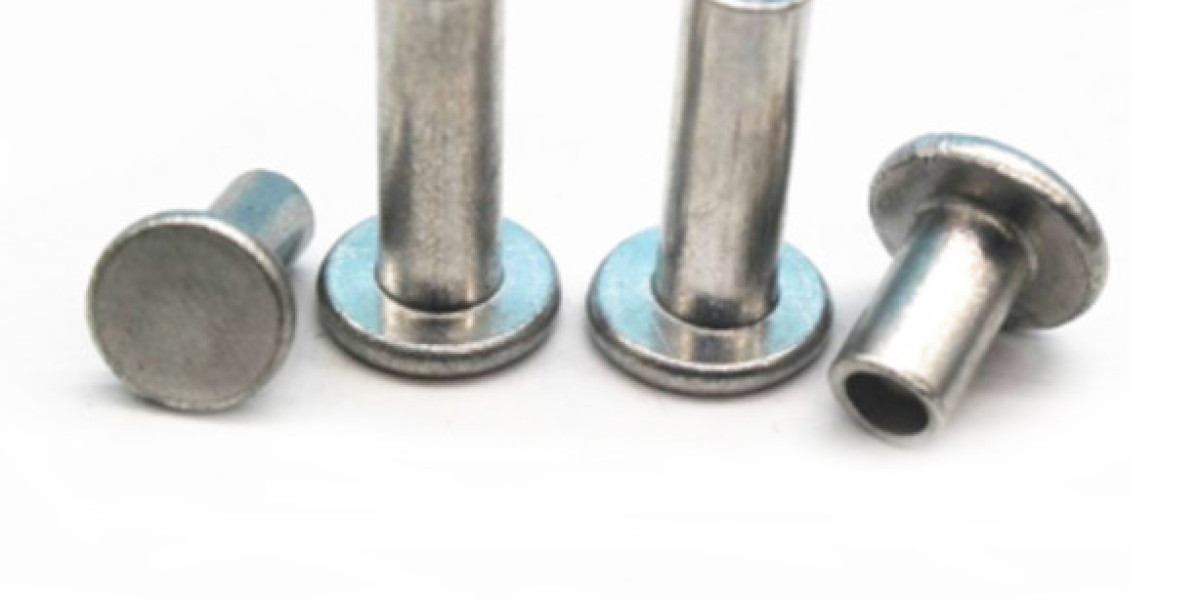Rivets are widely used in numerous industries for fastening materials together permanently. Whether in aerospace, automotive, construction, or shipbuilding, rivets provide a reliable and strong solution where a permanent bond is needed. Understanding the different Types of Rivets and their unique characteristics is essential for selecting the right one for a specific application. This guide explores the various types of rivets, their features, and the industries where they are commonly used.
What Are Rivets?
A rivet is a mechanical fastener that is used to join two or more materials together. It is typically composed of a cylindrical shaft with a head at one end. Once inserted into a hole in the materials being joined, the opposite end of the rivet is deformed to form a second head, securing the materials together. Unlike screws or bolts, rivets are permanent fasteners that cannot be easily removed or adjusted once they are set, making them ideal for situations where a permanent connection is required.
Rivets come in various shapes, sizes, and materials, and each type is suited for specific uses. Let's dive into the different types of rivets and explore their features and applications.
1. Solid Rivets
What Are Solid Rivets?
Solid rivets are the most traditional and robust type of rivet. They consist of a solid cylindrical shaft with a head on one end. When installing a solid rivet, the other end is deformed, either manually or with a machine, to form a second head, securing the materials tightly together.
Features of Solid Rivets:
- High strength: Solid rivets provide excellent tensile and shear strength, making them ideal for heavy-duty applications.
- Permanent connection: Once installed, solid rivets create a permanent bond between materials.
- Requires access to both sides: Installation requires access to both sides of the material being fastened.
Common Uses:
Solid rivets are used in applications that require a strong, permanent connection, such as in aircraft structures, bridges, heavy machinery, and shipbuilding.
2. Blind Rivets
What Are Blind Rivets?
Blind rivets are a type of fastener that can be installed from one side of the material. Unlike solid rivets, which require access to both sides, blind rivets allow for installation in areas that are difficult or impossible to reach from both sides. This makes them particularly useful in applications where access to the backside of the joint is limited.
Features of Blind Rivets:
- One-sided installation: Can be installed from just one side of the material.
- Mandrel-based: The installation tool pulls a mandrel that sets the rivet and creates a secure bond.
- Variety of materials: Blind rivets are available in aluminum, steel, copper, and other materials.
Common Uses:
Blind rivets are commonly used in industries such as automotive manufacturing, construction, and aerospace. They are ideal for fastening thin materials or for situations where only one side of the workpiece is accessible.
3. Pop Rivets
What Are Pop Rivets?
Pop rivets are a popular type of blind rivet, named after the "pop" sound they make when installed. These rivets are inserted into a pre-drilled hole, and a specialized tool pulls the mandrel to set the rivet, causing it to expand and secure the materials together. Pop rivets are known for their ease of use and fast installation.
Features of Pop Rivets:
- Quick installation: Easily installed with a hand-held rivet gun or tool.
- Lightweight and strong: Suitable for a wide range of materials and applications.
- Variety of sizes: Available in a range of diameters and lengths to fit various requirements.
Common Uses:
Pop rivets are frequently used in automotive assembly, sheet metal work, and furniture manufacturing. They are ideal for applications where speed and simplicity are essential.
4. Semi-Tubular Rivets
What Are Semi-Tubular Rivets?
Semi-tubular rivets are similar to solid rivets, but they have a hollow section at the tail end of the rivet. This hollow section makes them easier to install, requiring less force compared to solid rivets. Semi-tubular rivets are commonly used for applications where materials are thinner or less dense.
Features of Semi-Tubular Rivets:
- Hollow tail: The tail end of the rivet is partially hollow, making installation easier.
- Reduced force required: The hollow tail reduces the force necessary to install the rivet.
- Versatile: Suitable for a wide range of materials, from thin sheets to thicker sections.
Common Uses:
Semi-tubular rivets are often used in industries such as electronics, jewelry making, automotive, and light construction. They are ideal for applications where a strong but lightweight bond is needed.
5. Flush Rivets
What Are Flush Rivets?
Flush rivets are designed to sit completely flat against the surface of the material. The head of a flush rivet is countersunk into the material so that it does not protrude, which is important in applications where aerodynamics or aesthetics are a concern.
Features of Flush Rivets:
- Countersunk design: The rivet head is recessed so that it sits flush with the material surface.
- Aerodynamic: Ideal for use in applications where airflow and minimal drag are crucial, such as in aircraft.
- Smooth appearance: Flush rivets create a sleek, even finish, making them visually appealing.
Common Uses:
Flush rivets are commonly used in the aerospace industry for securing aircraft panels and parts. They are also used in automotive and high-performance vehicle construction, where appearance and performance are both critical.
6. Rivet Nuts
What Are Rivet Nuts?
Rivet nuts, also known as insert nuts, are designed to provide a threaded insert for bolted connections in materials that cannot support threading directly. These rivets are installed by pressing the nut into the material, creating a threaded hole that can accept a bolt or screw.
Features of Rivet Nuts:
- Threaded insert: Provides a secure threaded hole for fastening bolts or screws.
- Strong grip: Once installed, rivet nuts create a permanent, strong threaded connection.
- Easy installation: Can be installed with a hand tool or pneumatic tool.
Common Uses:
Rivet nuts are commonly used in automotive, aerospace, and furniture manufacturing. They are ideal for applications where a threaded connection is required, but the material being fastened is too thin to hold threads on its own.
7. Drive Rivets
What Are Drive Rivets?
Drive rivets are another form of fastener that is installed by driving a mandrel into the body of the rivet, which expands and secures the rivet in place. These rivets are typically used for light-duty applications where speed and ease of installation are important.
Features of Drive Rivets:
- Simple installation: Installed by hammering or pressing the mandrel into place.
- Quick and efficient: Requires minimal tools and effort for installation.
- Economical: Drive rivets are generally less expensive compared to other Types of Rivets.
Common Uses:
Drive rivets are often used in applications such as automotive trim, signage, and electrical enclosures. They are ideal for light-duty fastening tasks that require quick, simple installation.
8. Chestnut Rivets
What Are Chestnut Rivets?
Chestnut rivets are a type of rivet designed for use in metalworking, particularly in the construction of aircraft and large metal structures. These rivets have a flat, smooth head that creates an aesthetically pleasing and strong finish. They are primarily used for applications where both appearance and performance are essential.
Features of Chestnut Rivets:
- Flat, smooth head: Provides a clean, professional look with a flush finish.
- High-strength: Suitable for heavy-duty applications in metal construction.
- Used in high-performance applications: Common in aircraft manufacturing and other industries requiring strength and appearance.
Common Uses:
Chestnut rivets are primarily used in the aerospace and aircraft industries, where both functionality and visual appeal are critical. They are also used in high-performance metalworking projects.
Conclusion
Rivets are indispensable fasteners that are used across various industries to join materials securely and permanently. The type of rivet selected depends on factors such as material thickness, strength requirements, access to installation sites, and aesthetic considerations. From solid rivets used in heavy-duty construction to pop rivets ideal for quick, one-sided installation, each type of rivet offers distinct advantages. By understanding the different Types of Rivets and their applications, manufacturers and engineers can make informed choices, ensuring that the best fastener is selected for the job at hand. Whether you're working in aerospace, automotive, or construction, there's a rivet type suited to your needs.








